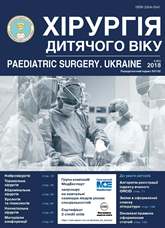Results of parenchymal-sparing pulmonary resections with bronchial reconstruction for diseases and injuries of bronchi
DOI:
https://doi.org/10.15574/PS.2018.61.31Keywords:
pulmonary neoplasms, parenchymal-sparing pulmonary resections, traumatic injuries of bronchiAbstract
The results of diagnosis and surgical treatment of bronchial diseases and injuries in 829 patients, including 92 (11 per cent) children aged from 8 months to 18 years and 737 (89 per cent) adults under the age of 76 years, are shown in the article. Among adult patients, women accounted for 271 (37 per cent) persons and men – 466 (63 per cent). The examination plan, in addition to general clinical methods, included thoracic multispiral computed tomography and endoscopy, histological and immunohistochemical assays to verify malignant tumours. In the case of malignant tumours, a positron emission tomography – computed tomography (PET-CT) was employed at the final stage of diagnostic assessment. Among the operated patients, the main group consisted of patients with tumours – 636 (77 per cent), of these 193 (23 per cent) patients underwent interventions for six diseases. Isolated bronchial resections were performed in 37 per cent of cases, and parenchymal-sparing bronchopulmonary resection with bronchial reconstruction – in 63 per cent. The main types of surgical interventions on the tracheobronchial tree were circular (62 per cent) and fenestrate (30 per cent) bronchial resection, the rest 8 per cent were other types of interventions. Out of 523 bronchopulmonary resections, a lobectomy was performed in 354 (68 per cent) cases, and other variants of parenchymal-sparing resection were made in 169 (32 per cent) patients. The surgeries were ended up with the standard restoration of bronchial tree integrity in 550 (66 per cent) patients, in 279 (34 per cent) patients – non-typical clinic-designed corrective multiaxial or polybronchial reconstruction was used. Postoperative mortality rate was 1.9%.References
Perelman MI, Biryukov Yu.V, Gudovsky LM etc. (2001). Surgery of the trachea and bronchi. Ann. surgery 1:30–35.
Ahuja S, Cohen B, Hinkelbein J, Diemunsch P, Ruetzler K. (2016). Practical anesthetic considerations in patients undergoing tracheobronchial surgeries: a clinical review of current literature. J Thorac Dis. 8: 3431–3441. https://doi.org/10.21037/jtd.2016.11.57.
Deslauriers J, Tronc F, Gregoire J. (2009, Jan). History and current status of bronchoplastic surgery for lung cancer. Gen Thorac Cardiovasc Surg. 57(1): 3–9. https://doi.org/10.1007/s11748-008-0316-x.
Madden BP. (2017, Jan.). Evolutional trends in the management of tracheal and bronchial injuries. J Thorac Dis. 9(1): 67–70. https://doi.org/10.21037/jtd.2017.01.43.
Maurizi G, D’Andrilli A, Venuta F, Rendina EA. (2016, Nov.). Bronchial and arterial sleeve resection for centrally-located lung cancers. J Thorac Dis. 8(11): 872–881. https://doi.org/10.21037/jtd.2016.06.48; PMid:27942409 PMCid:PMC5124599
Nagayasu T, Yamasaki N, Tsuchiya T, Matsumoto K, Miyazaki T, Hatachi G, Watanabe H, Tomoshige K. (2016, Jan.). The evolution of bronchoplasty and broncho-angioplasty as treatments for lung cancer: evaluation of 30 years of data from a single institution. Eur J Cardiothorac Surg. 49(1): 300–6. https://doi.org/10.1093/ejcts/ezv065
Palade E, Holdt H, Passlick B. (2015, Jun). Bronchus anastomosis after sleeve resection for lung cancer: does the suture technique have an impact on postoperative complication rate? Interact Cardiovasc Thorac Surg. 20(6): 798–804. https://doi.org/10.1093/icvts/ivv058.
Downloads
Issue
Section
License
The policy of the Journal “PAEDIATRIC SURGERY. UKRAINE” is compatible with the vast majority of funders' of open access and self-archiving policies. The journal provides immediate open access route being convinced that everyone – not only scientists - can benefit from research results, and publishes articles exclusively under open access distribution, with a Creative Commons Attribution-Noncommercial 4.0 international license(СС BY-NC).
Authors transfer the copyright to the Journal “PAEDIATRIC SURGERY.UKRAINE” when the manuscript is accepted for publication. Authors declare that this manuscript has not been published nor is under simultaneous consideration for publication elsewhere. After publication, the articles become freely available on-line to the public.
Readers have the right to use, distribute, and reproduce articles in any medium, provided the articles and the journal are properly cited.
The use of published materials for commercial purposes is strongly prohibited.

